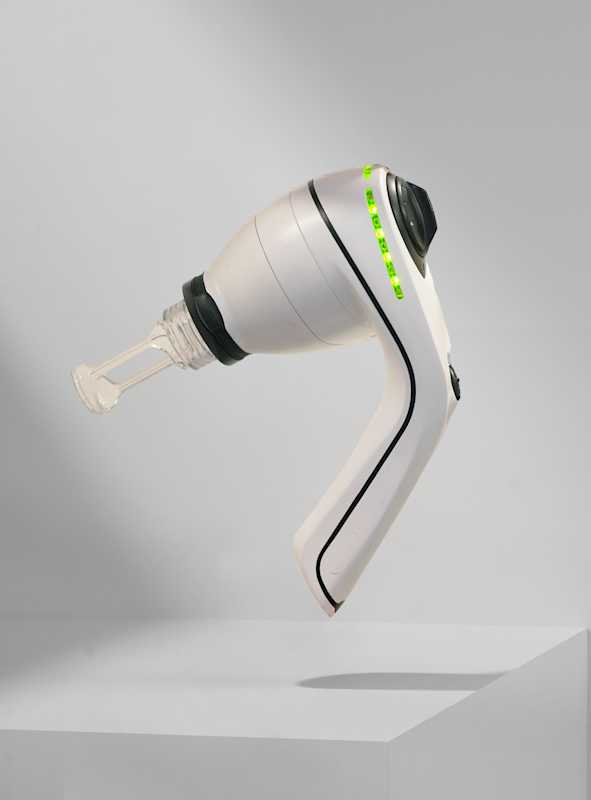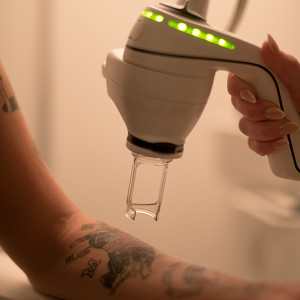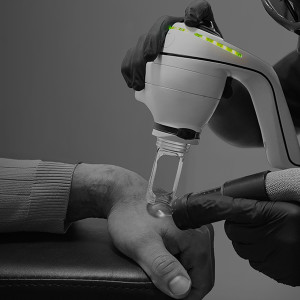To save our clients from trawling the web for answers, we’ve compiled a list of the most common questions about laser tattoo removal.
Here are seven of the most common laser tattoo removal questions answered in a single blog post.
Can I completely remove a tattoo with laser tattoo removal?
Yes, it is entirely possible to completely remove a tattoo with the right laser. However, a number of factors will impact how much of the unwanted tattoo ink is removed, and how fast.
Generally speaking, ink colour, ink type, and the position of the tattoo on the body will all impact how successful laser tattoo removal can be. The health of your immune system, as well as the quality of your sun and aftercare routines all play a part.
Speak to our laser tattoo removal experts for a personalised answer to this question or read this blog.
And make sure to do your laser research.
Talk to one of our experts to start your removal journey

The LightSense™ laser system, available exclusively at NAAMA

How soon can I remove my tattoo after getting it?
With a skin-safe laser you can remove a brand new tattoo almost immediately after first getting it. Our experts recommend waiting until your tattoo has completely healed which can take around six to eight weeks after first getting the tattoo before you start your removal sessions. This is so that the skin is in the best condition for laser tattoo removal.
Choosing a laser that works on low energy can help keep the skin surrounding a fresh tattoo safe and in fine condition.
How many sessions will I need?
This has got to be the question we get the most and at the same time, one of the most difficult to answer. Put simply, every tattoo is different, and people respond differently to laser tattoo removal. So a one-size-fits-all answer is difficult to give.
The more in-depth response is that there are three crucial aspects of laser tattoo removal treatment that impact how long it will take: the laser, your tattoo, and your health.
After selecting the LightSense™ laser system, the next step to consider is the constitution of the tattoo itself. Our expert consultants will examine your tattoo for an estimate of how quickly the ink will clear. The size, colour, density, depth and location on the body of the tattoo will determine how long it takes to remove.
At this stage of the removal journey communication between client and consultant is key.
As a general rule, small and faint tattoos tend to clear faster than large, dense tattoos. Tattoos that are closer to the heart tend to clear faster because of the increased blood flow in that area. Tattoos on the extremities, think little moustaches on fingers, will take a lot longer to clear.
Think of tattoo removal as a process that is kick-started by the laser, and supercharged by the lymphatic system. The stronger the immune system, the faster the removal.
How long do I need to wait between treatments?
Your specific amount of downtime will be assessed during your initial consultation and may change during the course of treatment.
It’s best to make our consultants aware of any planned holidays so that we can figure out how best to fit tattoo removal in around an everyday routine.
Will I see results immediately after laser tattoo removal?
With the LightSense™ laser system, NAAMA’s aim has been to offer tattoo removal in months, not years.
This is possible because of the reduced downtime between sessions and the accessible location of our Great Portland Street studio, just a stone’s throw from Oxford Circus.
Immediate results are possible, but the best way to view tattoo removal is as a process. This is why we document tattoos at each step of the journey through photographs and dermatoscopic imagery.
Once the initial session has kick-started the removal, the body’s lymphatic system continues the removal work over the following months.
So not quite “Rome wasn’t built in a day” but you get the idea. Laser tattoo removal is, in the words of Dr Fiona Worsnop, a Harley Street and NHS Consultant Dermatologist, “an ongoing process and commitment to the best skincare and therefore, the best outcome.”
What will my skin look like after my sessions?
Whilst this will be different for everybody, a good guide to how the skin will look and feel immediately after tattoo removal is to go by our previous clients.
Lucky, sword-swallower and NAAMA client, removed a colourful chest piece and had this to say about the process.
“Every time I have a session, it heals - and that’s one of the best parts about NAAMA. It's easier than getting the tattoo in the first place. The skin doesn’t bubble. Then, it starts to fade after a few sessions. Once the system has drained the ink pigment, you really start noticing the difference.”
Of course we can’t all be as fortunate (excuse us), but this gives a sense at least of the skin-safe capabilities of the low-energy LightSense™ laser system.
Read more about the laser’s credentials down below.
What is the best pico laser for tattoo removal?
At NAAMA we only use one: the LightSense™ laser system. It’s a type of pico laser with an incredibly short pulse width. Here are a couple of reasons why we choose to use it above all else.
LightSense™ delivers fast and effective results on ultra-low energy
The precise beam gives superb clearance results
Strongest doesn’t equate to fastest when it comes to laser tattoo removal
Read more about the many, many, many benefits of the LightSense™ laser system on our dedicated page.
Talk to one of our experts to start your removal journey









